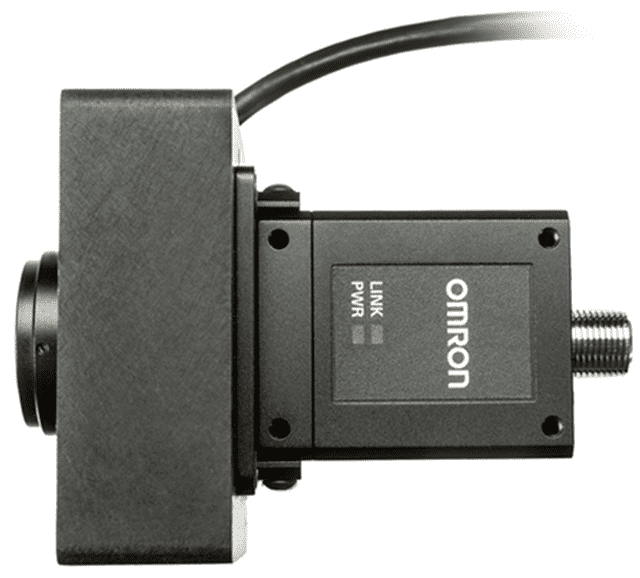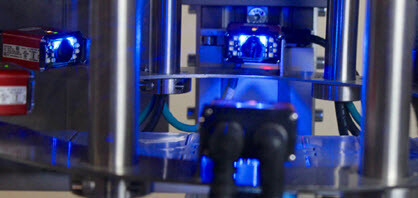Omron Barcode Readers
Fast, reliable barcode decoding for automation, traceability and lower costs.
Brochures
What is the difference between a barcode scanner and a barcode imager?
Barcode scanners
Barcode scanners use a laser to turn white and black 1D barcode stripes into binary information that can be decoded.
When to use a 1D barcode scanner:
Best for 1D barcode and/or a stacked symbol such as PDF417
Reliable performance at a lower cost than barcode imager
Faster than imager: over 1,000 real-time decodes per second
Sharp, clear laser line focuses on barcode
Reads over longer distances and with greater depth of field
Lasers are less complex than imagers and easier to use and integrate into an instrument
Barcode imagers
Barcode imagers are cameras that can use a sensor, lens and external lighting to capture an image of 1D or 2D barcodes that can be decoded.
When to use a barcode imager:
Reads both 1D and 2D barcodes such as data matrix and QR codes, which are capable of containing more information in a smaller area
Reads barcodes that are damaged or rotate orientation along a production line
Reads direct part marks (DPM) which are used to track products throughout their lifecycle
Capable of barcode quality verification
What are the methods for direct pay marking?
Electrochemical Etch
The electrochemical etch process uses a low voltage current to mark the object surface. This is commonly used for low volume product runs.
Inkjet
Inkjet marking uses small, dots sprayed directly onto the surface. Ink jet produces high contrast marks. Inkjet is not considered a permanent marking method.
Laser Etch
Lasers etch the symbol directly onto a surface. Clean, high-resolution marks are produced making laser-etch well-suited for automated environments and for making small size bar codes and alphanumeric characters. CO2 and fiber are common laser types.
Dot Peen
Dot peen is a percussive marking method, using changes in depth to create marks. Dot peen machines require regular maintenance in order to maintain mark quality.
How can I meed FDA requirements for direct marking?
What is UDI?
UDI stands for Unique Device Identification system.
Dictates a standardized method of coding medical devices with key identifying information.
Medical devices sold in the United States must be logged in a Global Unique Device Identification Database (GUDID) for consistency and transparency.
Enables traceability of devices throughout manufacture, distribution, and use.
What are the parts of a UDI code?
Device Identifier (DI) – A mandatory, fixed portion that identifies the labeler and the specific version or model of a device.
Production Identifier (PI) – A conditional, variable portion of a UDI.
How long does a device need to bear a UDI?
UDI must enable identification of medical devices throughout manufacture, distribution, and use regardless of handing, processing and use. A UDI is designed to protect consumers throughout the device lifecycle. Devices used only once before disposal or used multiple times by the same patient, do not require permanent UDI marks.
Does a UDI have to be on packaging and labeling or devices or both?
According to the FDA: “A device that must bear a unique device identifier (UDI) on its label must also bear a permanent marking providing the UDI on the device itself if the device is intended to be used more than once and intended to be reprocessed before each use.” — 21 CFR 801.45
Packaging and labeling may not stand the test of time. Permanent UDI marks ensure device information is always available, even when labels and packaging aren’t.
Why do I need a permanent mark when there is already a UDI on my label?
UDI is the only method of effectively tracing a device to know:
Where the device came from
Where the device is now
Where the device will be applied
UDI ensures adverse events (like product recalls) can be addressed quickly with minimal risk to the consumer. Remember: A direct part mark is typically the only identifier of your device after it is taken out of the package.
What are the deadlines to implement permanent UDI?
By Sept. 24, 2020 all Class I, Class II and Class III, and all other medical devices must have a permanently fixed UDI mark. The regulations were rolled out on this timeline:
2020 – Class I and All Other Devices: Class I devices require little regulatory control, like dental floss and gauze bandages.
2018 – Class II Devices: Class II devices are higher-risk devices like syringes, requiring regulatory controls to ensure safety and effectiveness.
2016 – Class III Devices: Class devices are the highest-risk devices, approved by FDA before release, like replacement heart valves and other implantable devices.
2015 – Implantable, Life-Supporting, and Life-Sustaining Devices
What is “permanent” or “direct” marking?
Direct part marking (DPM) is a process of abrading a code directly on to a device service. Unlike labels, DPM codes are not easily discarded, obsured, wiped off or degraded. DPMs ensure the availability of encoded information throughout the device lifecycle.
What is “reprocessing”?
Reprocessing is any process used to render a medical device fit for subsequent use. The process is used to remove blood, tissue, biological debris and other contaminants. Reprocessing is generally intended for devices that have repeated use on or by more than a single patient.
What is the required format of a UDI mark?
Unlike UDI on labels and packaging, a permanent UDI mark may be provided in either:
Human-readable format: Easily legible in plain-text format.
Machine-readable format: Able to be interpreted by automatic identification and data capture (AIDC) technology such as barcode readers, machine vision systems and/or RFID equipment.
What are the best practices for UDI marking?
Choose the best marking method for your device.
Choose a data carrier that suits your marking method and size of your device.
Choose a process for verifying UDI mark accuracy and quality, based on currently-accepted quality parameters.
How should I apply a direct part mark?
A direct part mark is made by altering a device surface to expose a pattern in a different reflectance or color. There are a variety of permanent direct part marking methods. The most common methods are: Laser etch, electromechanical etch and dot peen.
What DPM marking method should I choose to mark my products?
Non-intrusive marking methods should be used for balloons, catheters, or high-pressure and high-stress systems. Etching may be best in these cases.
Geometry
It is more difficult to mark a curved surface than a flat surface. Laser may be best for curved surfaces.
Device size
Small devices require small marks. In most cases, when a 2D symbol (like QR code or data matrix) is used, the size of the device is irrelevant (codes can be reduced to below 1/4 inch square).
Application environment/lifespan
A mark must last as long as the device is used, withstanding the same environmental conditions. Dot peen is the most hardy marking method.
Surface glossiness
Highly-polished metal surfaces are highly-reflective causing glare that can “blind” the reader or verifier. Glossy surfaces should be lightly textured to reduce glare prior to marking. Texture should extend 1 symbol-width beyond the marked area.
Surface roughness
Surface roughness should be limited to 8 micro-inches for dot peen marking. Laser systems are ideal for rougher surfaces because they first burn a “quiet zone” (smooth, blank area on the surface of the device where the symbol will be marked).
Surface thickness
Surface thickness must be taken into account to prevent deformation or excessive weakening of the device. The marking depth should not exceed 1/10 the thickness of the device to avoid compromising the safety of the device.
Integrator Case Study
EIS started developing its own front-end .NET programming for barcode verification targeted towards customers in any type of industrial environment. The system integrator chose to work with Omron thanks to the automation supplier’s global reach and the fact that all technologies are designed to work as a single solution. The two companies’ trusted relationship was also a major factor in the decision.

Who is Mechatronic Solutions?
Mechatronic Solutions is a distributor of OMRON automation products and solutions for Minnesota, Wisconsin, North Dakota, and South Dakota. We have a team of technical experts on staff to help select the right automation products for your application. If you have any questions or would like to speak with a member of our team, contact us at (763) 447-3407 or fill in the Contact Form.
Why Omron Barcode Scanners?
Omron helps manufacturers drive down costs, automate critical manufacturing processes and increase yields through data acquisition and control solutions.
Packaging Case Study
Omron designed a flexible system using six MicroHAWK ID-40/V430 cameras to minimize false rejects while keeping the overall machine footprint to a minimum.

Some of Omron’s Barcode Products
- V320
- V330
- v420
- v430
- V440
- V460
- NX1P Machine Controller
- S8VK-G Power Supply
- Sysmac Studio Software
CONTACT MECHATRONIC SOLUTIONS TODAY
Need barcode scanning and verification in Minnesota, Wisconsin, North Dakota, or South Dakota… Call Mechatronic Solutions at 763-447-3407 or fill in the Contact Us form today to work with our application engineers or schedule a demo.
